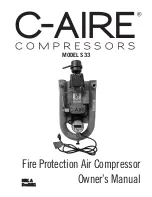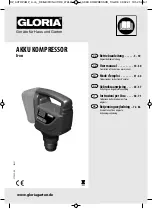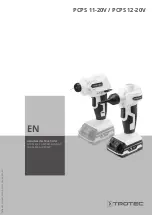
GB
12
-
Read the engine manual accompanying this compressor for
correct engine start-up maintenance procedures.
-
Read and understand the safety labels located on this
compressor.
-
A minimum of 85 octane fuel is recommended for use with this
compressor. Do not mix oil with gasoline.
-
Use of clean, fresh, lead free gasoline should be used. Do not
use gasoline containing methanol or alcohol.
-
Check the engine oil level before starting (See engine manual).
-
Fill the fuel tank according to the engine manual instructions.
WARNING: Follow all fueling instructions in operator’s
manual. Gasoline is extremely flammable, and
gasoline vapor can explode. Do not refuel fuel
tank while this compressor is running or hot.
Never smoke near gasoline, and keep other
flames and sparks away. Allow this compressor
and engine to cool down before refueling. Do not
refuel indoors or in a poorly ventilated area. Do
not fill fuel tank to point of overflowing. Always
refuel slowly to avoid the possibility of spilled
fuel which may cause a fire. Do not operate this
compressor if gasoline is spilled. Wipe this
compressor clean and move it away from the
spill. Avoid creating any ignition until the
gasoline has evaporated. Allow approximately
1/4” of tank space for fuel expansion. Always
store fuel away from this compressor while it is
running or hot. Always store gasoline in an
approved container.
-
Refer to the engine manual for all necessary maintenance
and adjustments.
WARNING: Do not operate this compressor in an enclosed
area. Use this compressor only in well ventilated
areas. The exhaust from the engine contains
carbon monoxide, a poisonous, odorless and
invisible gas. Breathing the gas can cause
serious injury, illness and possible death. Avoid
inhalation of exhaust gas. Never run the engine
in a closed garage or confined area.
Ensure the oil level in this compressor pump is adequate. If the
oil level is low, replenish oil through the filling hole so that the
amount of oil will come to the middle of the oil sight glass
according to the following OIL TYPE CHART.
OIL TYPE CHART
Ambient
temperature (°C)
10~50
(°C)
-30~50
(°C)
Non-detergent oil
FIAC OIL 150
graded oil
for warm winter
use only
SAE5W50
synthetic oil
for both summer
and winter use
Pre-start checklist
a. Oil level should be checked on a daily basis to ensure it does
not exceed the maximum notch or does not fall below the
minimum notch on the oil sight glass. If the oil level is low,
replenish oil through the filling hole so that the amount of oil
will come to a point between the maximum notch and the
minimum notch of the oil sight glass according to the OIL
TYPE CHART.
CAUTION: Overfilling with oil will cause premature
compressor failure. Do not overfill.
b. Remove any moisture in this compressor air tank. Gradually
open the drain cock and discharge the drain. Close tightly
when drained.
c. Make sure the engine switch is in the “OFF” position.
d. Make sure all guards and covers are in place and securely
mounted.
OPERATION
Start-up
a. Read safety warnings before performing operation.
b. When the toggle (T) is in the upright position, all air from this
compressor is vented through the discharge muffler (fig.5).
This gives an easy start feature. For normal operation, the
toggle (T) is in the 90° position.
c. Start engine (Refer to the Engine Manual accompanying this
unit).
d. When the engine has run for 1-2 minutes, flip toggle (T) back
to the original position.
The operation of this compressor is automatic and is
controlled by the pilot valve (P) which idles it when the
pressure in the air-tank reaches the maximum level and
restarts it when the air pressure drops during use to the
restart level. The pilot valve is preset by the manufacturer
and must not be modified in any way.
WARNING: If you notice any unusual noise or vibration, stop
this compressor.
CAUTION: Wear appropriate personal hearing protection
during use. Under some conditions and duration
of use, noise from this product may contribute to
hearing loss.
ADJUSTING OPERATING PRESSURE
You do not have to use the maximum operating pressure at all
times. On the contrary, the pneumatic tool being used often
requires less pressure. On compressors supplied with a pressure
reducer, operating pressure must be correctly adjusted. Release
the pressure reducer knob by pulling it up, adjust pressure to the
required value by turning the knob clockwise to increase
pressure and anti-clockwise to reduce it. When you have
obtained optimum pressure, lock the knob by pressing it
downward (fig. 6).
WARNING: Some pressure regulators do not have "push
to lock", therefore simply turn the knob to
adjust the pressure.
WARNING: Check the manufacturer’s maximum pressure
rating for tools connected to the compressor and
accessories. Compressor outlet pressure must
be regulated so as to never exceed the maximum
pressure rating for tools connected to the
compressor.
Shutdown
a. To stop this compressor, move the engine switch to the “Off”
position (Refer to the Engine Manual accompanying this unit).
b. Gradually open the drain cock, take out the drainage and all
the compressed air inside the tank to prevent any internal
corrosion of the tank (fig.7).
WARNING: Risk of bursting. When the tank gets corroded,
there is a risk of breakdown. Water will condense in
the air tank. If not drained, water will corrode and
weaken the air tank causing a risk of air tank rupture.
Drain tank daily or after 4 hours of use. The drain
contains moisture in the air, abrasion particles, rust,
etc. To drain tank open valve slowly and tilt
compressor to empty accumulated water. Keep face
and eyes away from drain cock.
c. Allow the compressor to cool down
d. Wipe this compressor clean and store in a safe, non-freezing
area.
Prematic AG, Märwilerstrasse 43, 9556 Affeltrangen www.prematic.ch
Tel. 071 918 60 60, Mail: info@prematic.ch













































